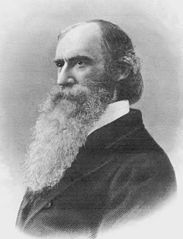
In chapter five of T. T. Martin’s Hell and the High Schools (1923), which abounds in quotations that supposedly show (in the words of the chapter’s title) “Evolution Repudiated by Great Scientists and Scholars,” there appears a paragraph reading, simply, “Prof. John S. Newberry: ‘It is doubtful if at any time in the world’s history there has been a theory that has gained so great a popularity with such an unsubstantial basis as that of Evolution of man from the lower orders.’” No identification of Newberry or of the publication is provided in the text. The context is not helpful, either—the paragraph is preceded by a quotation from Eduard von Hartmann and followed by a quotation from William Hanna Thomson (whose surname, for a wonder, Martin correctly spells without a p), neither of which is particularly relevant.
I swiftly found that Alfred Fairhurst’s Theistic Evolution (1919) offers a similar passage, attributed to “Prof. John S. Newbury”: “When, therefore, all these facts and the laws that govern them are taken into account, one is justified in saying that it is doubtful if at any time in the world's history there has been a theory that has gained so great popularity with such an unsubstantial basis as that of the evolution of man from the lower orders.” In the immediately preceding sentence, Fairhurst says that Newbury “has shown that not one ‘new species of flora has appeared on earth since the appearance of those that followed the great ice era.’” Finding it hard to believe that Newberry (or was it Newbury?) would have reached a conclusion about human evolution on the basis of a claim about post-Ice Age plant speciation, I nevertheless reserved judgment.
Part of the confusion was resolved when I reached Luther Tracy Townsend’s Adam and Eve, History or Myth? (1904). There, in a section entitled “Biology and Evolution: Origin of Man” in a chapter entitled “Whence the First Perfectly Developed Man; Theories of Evolution, Atheist and Theistic,” Townsend is arguing that animals—at least mollusks, fish, reptiles, and mammals—appear “fully equipped and in the plentitude of their power” in the fossil record, with no sign of ancestral species and no trace of descendent species. He then turns his attention briefly to plants: “And, too, as Prof. John S. Newbury has shown, not one ‘new species of flora has appeared on earth since the appearance of those that followed the great ice era.’” Ending the quotation, he continues in his own voice, “When, therefore …”—the passage quoted by Fairhurst and partly by Martin.
So Fairhurst and Martin, or whatever sources they consulted, apparently misread Townsend as quoting Newberry/Newbury rather than as expressing his own view. That mystery solved, I was still wondering whom Townsend was quoting. His earlier Evolution or Creation (1896) offered a decisive clue. There Townsend indicates that he was discussing a talk that Newbury gave before the Torrey Botanical Club of New York. As it happens, the president of the club from 1880 to 1889 was John Strong Newberry—so Martin, for a welcome change, got the surname right! Newberry (above; 1822–1892) was a distinguished geologist and paleobotanist of his day, serving as the chair of geology and paleontology at Columbia College (now University), the director of the Ohio Geological Survey, and the president of the American Association for the Advancement of Science.
So Newberry was certainly a reasonable authority to quote on the topic of post-Ice Age plant speciation. The problem is that Townsend may have confabulated the quotation from him. From the discussion in Evolution or Creation, it’s clear that Townsend was discussing “The Geological History of the North American Flora,” a talk that Newberry gave on May 11, 1880. The Bulletin of the Torrey Botanical Club printed the abstract of his talk in that year, but there is no claim there about no new species of flora emerging, much less the exact words attributed to Newberry. The closest Newberry comes is to say that today’s flora “retain[s] all the essential botanical characters of that of the Tertiary.” In the absence of any independent confirmation that Newberry uttered the words attributed to him by Townsend, I see no reason to accept Townsend’s word for it.
Moreover, it is hard to believe that Newberry would have asserted the claim attributed to him. Newberry was focusing on North America, so it would be overreaching for him to refer to no new species appearing on the whole planet since the last ice age. Plus, since he was aware of the incompleteness of the fossil record, he would certainly have hedged by saying that there is no evidence of any new species of flora emerging since the last ice age, rather than deny the existence of such species altogether. Furthermore, in discussing the differences between the Cretaceous and the Tertiary flora, Newberry explicitly wrote, “Many new genera and species were added,” so he evidently thought that it was possible for new species to arise in general: what, except for its recency and brevity, is special about the period since the last ice age?
Ironically, Newberry provided what could have been excellent fodder for the likes of Townsend, Fairhurst, and Martin somewhat earlier in his career. In 1867, in his presidential address to the AAAS on “Modern Scientific Investigation: Its Methods and Tendencies,” despite expressing his respect for Darwin’s “enthusiastic devotion to the study of truth” and condemning “the obloquy and scorn with which [Darwin’s suggestions] have been received in many quarters,” he firmly stated that “the Darwinian hypothesis is not accepted and can never be fully accepted by the student of science who is inspired with the spirit of the age.” He also cited eusociality in insects, “beauty,” and the origin of life as problems for “the Darwinian theory.” That said, he seems not to have indulged in any further criticism along those lines.

